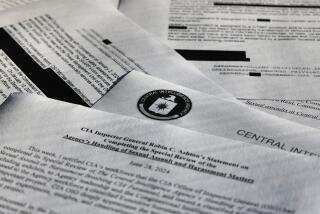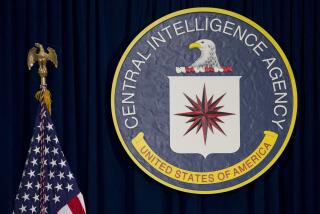BOOK MARK : How a Hunt for Moles Weakened the CIA’s Ability to Unearth Them
Any large organization rests on trust, or it could not function. Among its members, there is a presumption of loyalty to the organization, to their common goals and to each other. As Robert T. Crowley, a veteran officer in the CIA’s clandestine Directorate of Operations, put it, “In operations you have to ask, ‘Would I want this guy on my air hose at two hundred feet?”’
The Central Intelligence Agency too, rests on trust, but assumes betrayal. That is its continuing dilemma.
The era of the mole hunt brought into sharp relief the potential threat posed to any organization that has built into its basic structure a powerful unit in charge of suspecting everyone. A Department of Paranoia, as it were.
James J. Angleton, who directed the agency’s counterintelligence for two decades, devoted the last 13 years of his career to finding “the mole” or moles in the agency. Angleton was the CIA’s Captain Ahab, endlessly pursuing the great white whale. He never even got close enough to throw a harpoon.
It is hard, and perhaps unfair, to make the case that Angleton was paranoid. His suspicions had a rational basis. There were moles and traitors in other intelligence agencies. Even in the CIA, moles and traitors would surface.
But like so much in a democratic system, rooting out spies requires a delicate balance between security and liberty. The CIA is not exempt from due process. The agency is free to practice its black arts against other nations, subject to certain minimal presidential and congressional restrictions, but it cannot, at least when dealing with its own officers, operate outside the democratic norms of the system it professes to defend. It cannot, without great cost, trample on the values it was created to protect.
The mole hunt in the CIA destroyed the careers of loyal officers, shattered lives and families, and paralyzed the agency, bringing to a halt its operations against the Soviet Union at a time--the height of the Cold War--when those operations were the CIA’s raison d’etre.
Like a snake eating its tail, the mole hunters eventually devoured each other. The mole hunt turned on itself, and led to the spectacle of the chief of the Soviet division, the chief of counterintelligence, even the director of the CIA being accused. David Murphy, Angleton, and William E. Colby were touched by the corrosive finger of suspicion. The Soviet division’s operations virtually halted.
In the greatest irony of all, as a direct consequence of the mole hunt, counterintelligence within the CIA was also diminished, its size, influence and effectiveness greatly reduced.
When Colby took over as CIA director in 1973, he was rightly convinced that Angleton had become a destructive force within the CIA. The belief of the counterintelligence staff that all Soviet defectors or volunteers were plants and that the agency itself was deeply penetrated had frozen the CIA’s operations against the Soviet Union around the world. Determined to change this and to maneuver Angleton out of the agency, Colby dismantled his empire. The pieces were never put back together.
With his excess of zeal, Angleton had succeeded in destroying all that he had worked for. The world of counterintelligence is rather like a cave -- so deep, so dark, that no one can fully see into all of its crevices. But the basic task of CIA counterintelligence is to prevent penetrations and to help detect foreign spies.
In the end, Angleton self-destructed.
Angleton’s deep-seated belief that Soviet walk-ins or defectors after Anatoly M. Golitsin were all plants died hard, even after Angleton himself had gone.
In 1976, two years after Angleton’s departure, Adolf G. Tolkachev, a Soviet defense researcher working on Stealth technology for aircraft, began leaving notes in the cars of U.S. diplomats near the U.S. Embassy in Moscow. Tolkachev, fearing KGB surveillance, did not dare to approach the embassy itself. The CIA’s Moscow station relayed these approaches to the agency’s headquarters.
Three times, Tolkachev was turned away by the CIA, which feared he might be a plant. Finally, the agency decided to take a chance and began accepting material from the Soviet defense researcher. For almost a decade, Tolkachev proved to be the CIA’s most valuable asset inside the Soviet Union, his existence a closely guarded secret. Because of the agency’s initial suspicion, it had come close to losing his rich haul of Soviet secrets. Tolkachev was finally caught--betrayed, almost certainly, by Edward Lee Howard, a CIA case officer turned Soviet spy.
In the end, it all came back to betrayal. The need for trust, the reality of betrayal, transcend the dilemma faced by the CIA and the mole hunters of the 1960s. They are at the core of human relationships.
John Denley Walker, a former CIA station chief who saw it all from the inside but managed to keep a sense of balance, summed up: “The mole hunt,” he said, “probably did more to protect the Soviet agent, if there was one, than to unmask him. While everyone was being investigated and accused, the real mole was sitting back laughing.”
1992 by David Wise. Reprinted by permission of Random House.
BOOK REVIEW: “Molehunt: The Secret Search for Traitors That Shattered the CIA,” by David Wise, is reviewed on Page 1 of the Book Review section.
More to Read
Sign up for Essential California
The most important California stories and recommendations in your inbox every morning.
You may occasionally receive promotional content from the Los Angeles Times.










